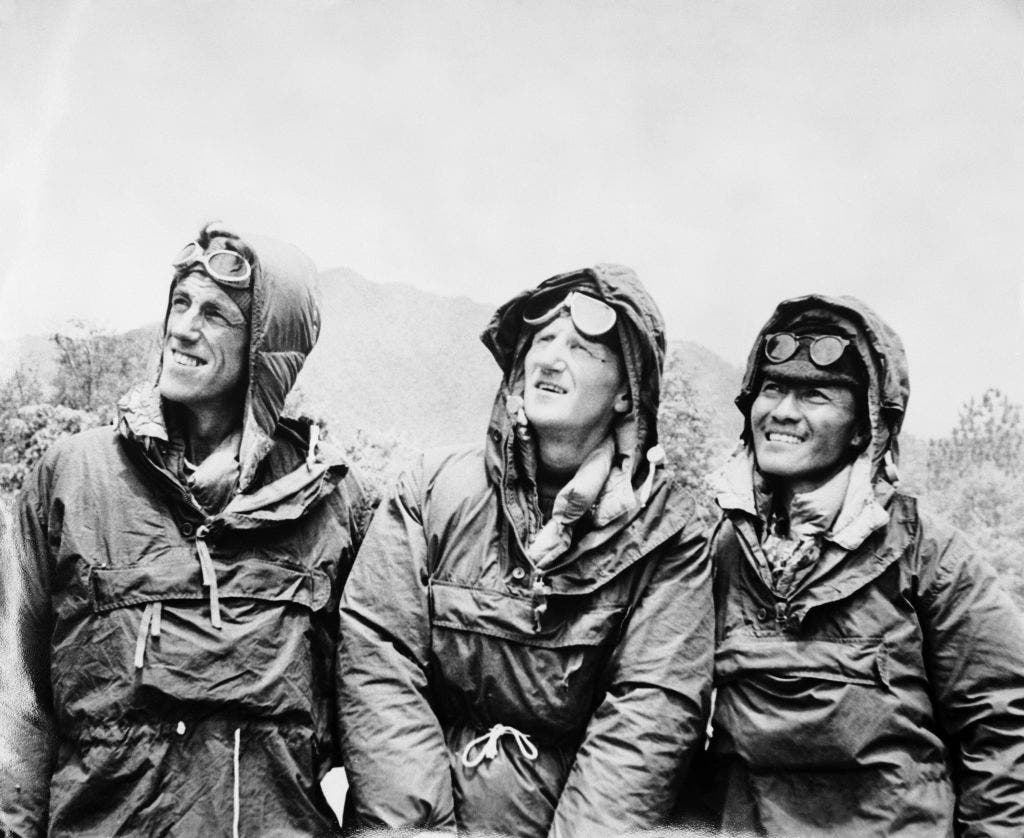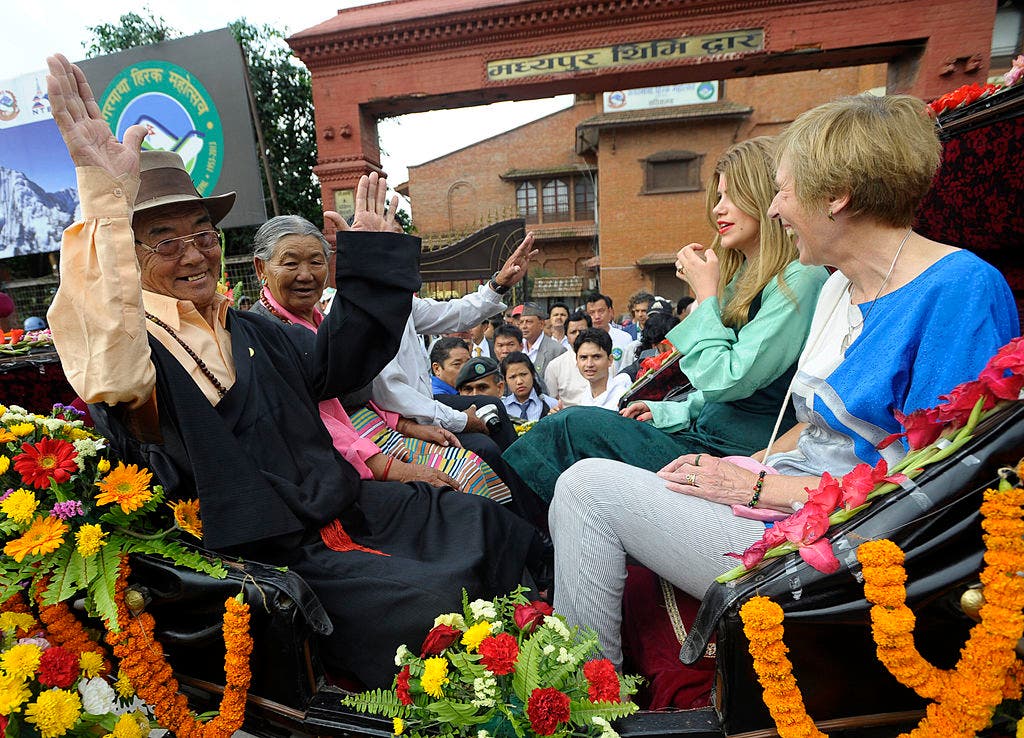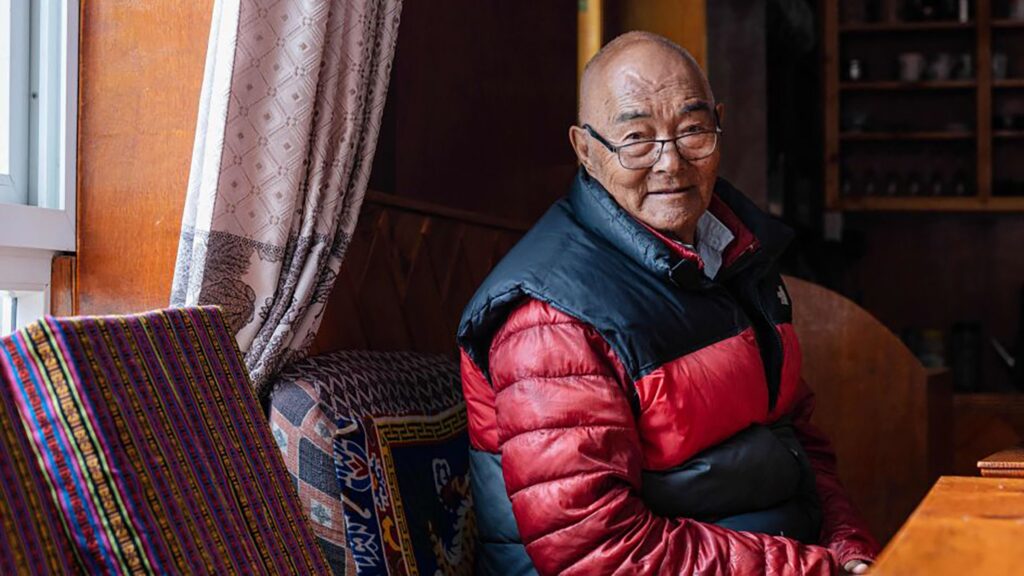Updated October 17, 2025 03:48PM
Kanchha Sherpa, the last surviving member of the 1953 expedition to reach the top of Mount Everest, died on Thursday, October 16.
Kanchha Sherpa was 92.
Outside interviewed Kanchha Sherpa’s son, Tshering Penjo Sherpa, who told anecdotes of his father’s connection the Mount Everest region, prior to its transformation by international tourism.
Tshering Penjo also shared details from the historic 1953 expedition to the summit of Mount Everest—and the pivotal job that Kanncha Sherpa played in helping Sir Edmund Hillary and Tenzing Norgay Sherpa reach the top.
Kanccha died at the house of his son, Tshering Penjo Sherpa, on the outskirts of Kathmandu. He had recently been brought to Nepal’s capital city from his ancestral home village of Namche Bazaar, the gateway to Everest, to undergo treatment for stomach cancer. He was receiving treatment for the disease at a nearby hospital, Tshering Penjo Sherpa told Outside.
Mount Everest Before the Tourists
Born in a poor Sherpa family in Namche, Kanchha never attended school.
When he was a child, Namche village wasn’t connected to the outside world by roads or mass communication. The village had no school and no health facilities, and the tourism industry had yet to transform the region.
Kanccha remained illiterate throughout his life. His only writing was his own signature in English, which was taught to him by his mentor, Tenzing Norgay Sherpa.
With little available work opportunities in Namche, Kanchha, as a teenager, he traveled great distances by foot to build personal friendships and business opportunities outside of the community. He frequently trekked to Tibet, crossing high mountain passes, to trade sheep wool and salt in exchange for the corn and millet that his family grew in their home village. He sold the goods to help feed his family. Kanccha also trekked down to Nepal’s southern border with India to trade for rice.
“His lifestyle was difficult. We have had to wait for a festival to get rice. Had to rely on shamans if someone in our family got sick,” his son Tshering Penjo Sherpa told Outside.
In 1952, when he was 20 years old, Kanchha left Namche and walked for four days to reach Darjeeling, India, in search of a job. At the time, the Indian city was a hotbed for mountaineering expeditions into the Himalayas. Trips were organized by other Sherpas who were already living there.
Through a friend of his father, Kanchha met Tenzing Norgay Sherpa, and he worked at Tenzing Norgay’s house for three months. The job helped him form a bond with the Sherpa mountaineer, and Tenzing Norgay eventually invited Kanccha to participate in the groundbreaking 1953 trip to climb the world’s highest peak.
An Elite Sherpa on Everest
Alongside eight other Sherpas, Kanccha and Tenzing Norgay returned to Nepal by train—they later walked from Kathmandu back to Namche alongside Hillary. Upon arriving in Namche, the expedition used 60 yaks and 400 porters to ferry gear to the base of the mountain.
The team set up camps along the 30-mile route, which has since become a popular destination for trekkers. But in 1953, the trail was virtually empty.
“We have had to establish six camps from Namche to reach Base Camp,” Kanchha told the Annapurna Post, a Nepali language daily newspaper, in January 2022, “No one was really aware of establishing camps on the way to Base Camp.”

When they arrived at the present-day Mount Everest Base Camp, the area was covered in knee-high snowfall. The team then had to find a way to navigate the dangerous Khumbu Icefall.
“Aluminum ladders were not invented during their expedition days. So, my dad and other Sherpas chopped three pine trees in Namche and ferried wooden logs to the base camp to fix them over glaciers,” said Tshering Penjo, “That eased the load ferrying over Khumbu glacier.”
Out of 35 core members of the expedition team, 20 Sherpas were assigned to venture above Base Camp. Of them, just three Sherpas were assigned to climb to the highest camp at 27,000 feet, carrying oxygen loads and other essentials. Kanchha was one among the three.
Sherpas worked in rotations, continuing to haul gear upward until they fixed a tent at the final camp. Kanchha’s primary responsibility was to carry kerosene and stoves for cooking. For climbers, Champa, a porridge made of barley, was the main dish.
Shortly after Kanccha made his final trip to and from the high camp, Norgay and Hillary made their successful push for the summit, reaching the top on May 29, 1953.
“They stayed at the tent that we had set up. We stayed at the lower camp The next day at 1 P.M., they successfully reached the summit,” Tshering Penjo said, relaying his father’s story of the climb. “They succeeded in 45 days since the expedition began.”
Kanchha’s daily salary during the historic Everest expedition was 8 Nepalese Rupees, or about $1.30 in 1952. He was also given crampons, climbing equipment, and sleeping bags. In recognition of his contribution to climbing, Kanchha was awarded medals by British Queen Elizabeth II and the Government of Nepal.
“Except for two medals–one given by Queen Elizabeth II and another one by the government of Nepal he sold all of his climbing essentials,” said Tshering Penjo, “He did that to feed us and settle daily expenses.”
A Career in Expeditions and Trekking
After the 1953 expedition, Kanchha continued working at high altitude on other trips. But he never reached the summit of an 8,000-meter peak.
“He was always stuck below the summit,” said Ang Tshering Sherpa, former president of Nepal Mountaineering Association, the umbrella body of Nepali mountaineers. “In early climbing days, it was difficult to obtain climbing permits, especially for Sherpas. That’s for not having enough royalty to pay to the government.”
The dynamic confined many elite Sherpas to working as porters, kitchen boys and high-altitude helpers.
The successful ascent in 1953 lured additional foreign climbers to the Mount Everest region. Highly skilled Sherpas helped many of them to reach the summit. These expeditions, however, claimed the lives of many other Sherpas, and their deaths in avalanches and falls cast a shadow on the budding industry.
“Don’t go to Everest, it’s too risky,” Kanccha’s wife, Ang Lakpa Sherpa, famously warned him. “Children are too small. What happens if you die there?”

Kanccha continued to work as a high-altitude helper, but in the second half of his career he became a trekking guide. For 28 years he brought foreign tourists on long hikes to some of the most scenic regions of the Himalayas: Everest, Mustang, Kanchenjunga and Annapurna, among others.
In his final years, Kanccha mostly stayed in Namche, praying three to four times a day in the local monasteries. In 2018, he established a foundation dedicated to preserving traditional Sherpa culture.
The Kanchha Sherpa Foundation issued tickets for both domestic and foreigner visitors if they wanted to meet and interact with him. The voluntary donation collected from visitors in the name of the foundation s supporting the improvement of health and education of the Namche area. The fund was also used to protect Sherpa culture and music.
Kanccha steered his two sons away from the mountaineering industry, instead pushing them to operate hotels in the Mount Everest region, where they also help run schools and social programs.
“Having faced several difficulties in the mountains, he never encouraged us to work as climbing guides. We also didn’t choose climbing as our profession,” said Lakpa Tenzing, one of Kanchha’s sons.
Worried by the over-commercialization of Mount Everest, Kanchha often expressed frustration over the crowds, parties, and extravagant accoutrements at Base Camp.
“Everest must get rest,” he often told his family.


